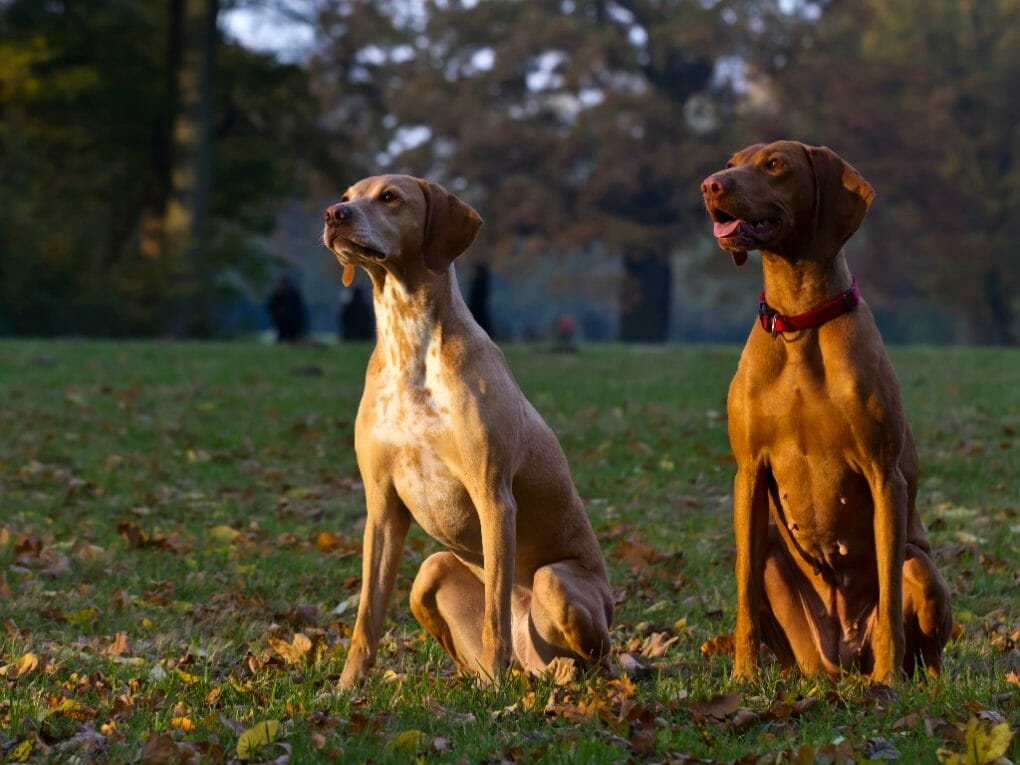Vizsla Male vs. Female: Comparing the Various Characteristics of This Breed Between Genders


Female Vizslas are the same as male Vizslas; only they have shorter coats. Both are great family pets because they’re friendly and easy to train. Female Vizslas can be distinguished from male Vizslas by their breasts – female Vizsla coats will not cover them completely.
Table of Contents
Key Similarities and Differences Between Male and Female Vizslas
Physical
Vizslas come in both male and female varieties, with physical differences you should be aware of. Male Vizslas typically weigh more than females and have longer hair on their backs and tails. Female Vizslas tend to be smaller overall, with shorter hair all over their body except for their head and tail, which can be thick.
In addition, males typically have a longer snout and smaller ears than females, which may contribute to their unequal treatment in some societies. They are also naturally taller and heavier than females, meaning they require more food for the same amount of weight.
Furthermore, males tend to have more enormous genitals than females – this is often seen as an indicator of their sexuality and dominance within social groups. Males also generally experience a higher libido than women – this could account for their more significant activity outdoors or during sexual encounters.
On the other hand, female animals are typically smaller and have shorter fur than their male counterparts. They also have smaller heads and body sizes and greater agility in movement. Females usually weigh less, too, due to their lower muscle mass.
Temperament
Both male and female Vizslas can be a little temperamental at first. But, with patience and training, they’ll eventually learn to trust you. To get started, take time to train your Vizsla properly. This will help them become obedient and friendly. After that, it’s time for obedience classes!
Males are more temperamental than females, which can manifest in many ways. For example, they may be more active, have a higher energy level, or be bossy. Conversely, females are usually calmer and easier to get along with – making them better team players.
Females are more sensitive than males when it comes to their environment. This can make them more temperamental in new surroundings, more challenging to train, and may housebreak. Females also tend to be more vocal when puppies – so it’s crucial to receive training early so as not to disturb their neighbors too much!
On the other hand, males don’t seem to be as fussy about their surroundings, which can make training them a lot easier as they tend to react similarly in any new environment they’re introduced to. This makes them less likely to create problems or damage property while roaming freely.
Both male and female Vizslas make great pets for people living in apartments or with small yards. They’re also great for people who are active and enjoy outdoor activities.
Trainability
Both male and female Vizslas are considered to be trainable dogs. This is primarily due to their motivation by treats and praise. As such, you’ll need to be prepared to give your Vizsla plenty of good food and positive reinforcement when training them.


Don’t force them into doing something they don’t want to, and be patient – this breed takes time to learn new things. Make sure you have a Vizsla breed book or online guide to help you, as it can get confusing when training a Vizsla for the first time. Remember, obedience training starts with building trust and confidence between you and your Vizsla.
Female Vizslas are just as capable as their male counterparts regarding training and hunting. Females may even be better at some tasks than males. Therefore, there is no need to change the way you train your Vizsla simply because it’s a female – give her the same level of care and attention as any other dog in your household.
Female Vizslas make great family pets, too – they’re gentle by nature and usually well-mannered indoors. So if you’re looking for an excellent hunter with tons of personality, a female Vizsla might be precisely what you’re looking for!
Health
There are many differences between male Vizslas and female Vizslas, some of which are health-related. Male Vizslas are typically larger and have a more pronounced ridge across their backs. Female Vizslas are smaller, with softer fur and less of a ridge on their back.
Male Vizslas generally weigh more than female Vizslas, but this is only sometimes the case. The male reproductive system is also different – it includes two testes that produce spermatozoa, while the female reproductive system only has one ovary that produces ova (eggs).
Male Vizslas are predisposed to some health issues that are more common in males. These include problems with their kidneys, heart, and reproductive organs. You can manage some of these issues through proper diet and exercise, but others require medical intervention. If you’re planning to get a Vizsla, it is crucial to keep these health concerns in mind before deciding.


As you might know, female Vizslas are more prone to skin problems and allergies. They also risk developing cancer, heart disease, and obesity. Meanwhile, males are more sensitive to sounds, smells, and light.
Vizsla owners should be aware of these health differences to make the best choices for their dog’s well-being.
How to Choose the Right Vizsla Gender
Choosing the right Vizsla for you is crucial, and it doesn’t just come down to whether or not you’re a male or female. So it’s essential to consider which gender suits your personality best.
Male Vizslas are typically more active and playful than female Vizslas and may be more vocal about their personality traits. Female Vizslas may be less energetic but make better house pets because they’re quieter and mellower.
Both genders can have the same personality traits. It’s just that male Vizslas tend to be more vocal about them. So, if you’re looking for a loyal, gentle, and fun-loving dog, then a male Vizsla is the right choice.
